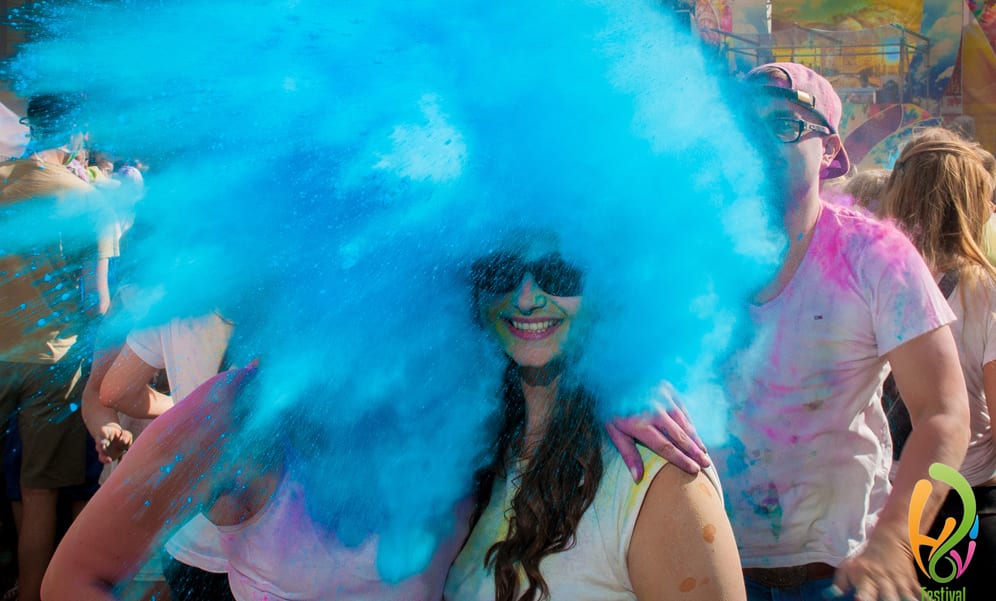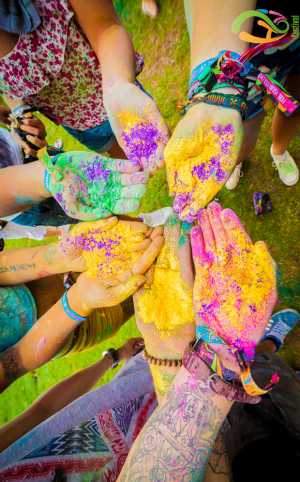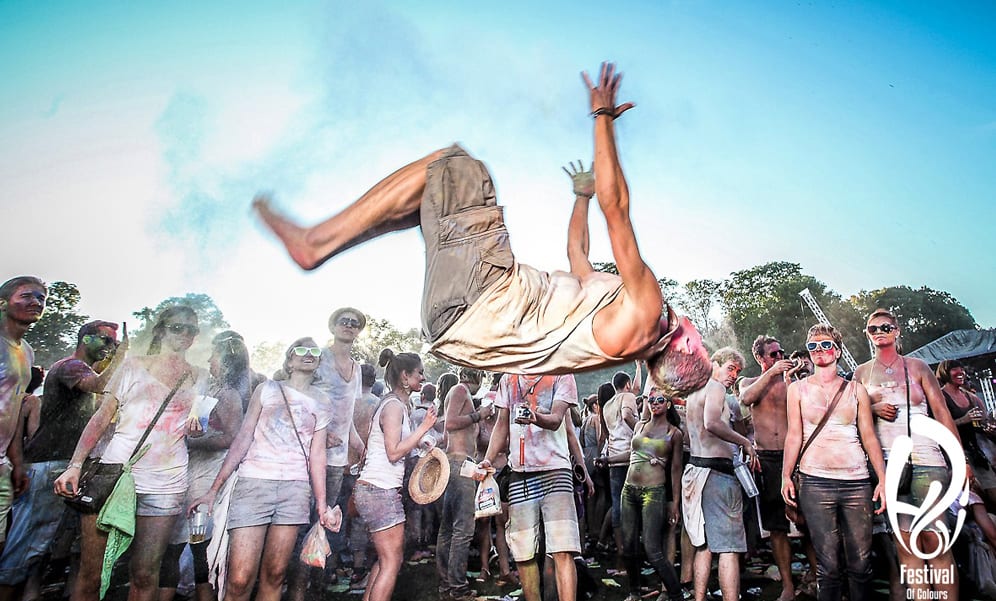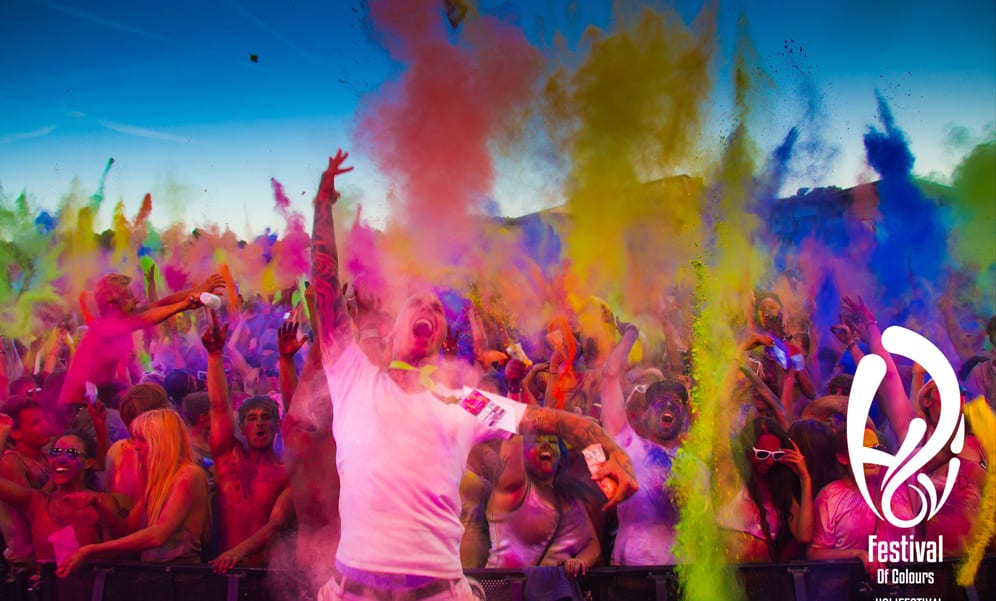I had never imagined such a festival existed. A moment in time when music and color become one, they explode. They become the outer most representation of our being. I am talking about the Festival of Colors. It is a concert like event with music and colored powder. It takes place on 4 different continents.
[caption id="attachment_3233" align="aligncenter" width="996"] Festival of Colors © Solkes[/caption]
Festival of Colors © Solkes[/caption]
The inspiration
Visibly, such an event has a back history to it. It is actually inspired by the traditional Hindu festival “Holi”. The Hindu festival usually takes place in March and marks the coming of spring. People throw powdered paint, known as gulal, at one another. It’s amazing, for one entire day in India the distinctions between castes, religions and gender are set aside and everyone is equal.The Holi Festival has its origins in India. As a matter of fact, it is a Hindu spring festival. Many know it as a festival of sharing love. It is an ancient Hindu religious festival which has become popular with non-Hindus in many parts of South Asia, as well as people of other communities outside Asia. However, in recent years the festival has spread to parts of Europe and North America as a spring celebration of love, romp, and colors. Laura Viera A: What was your experience? Martin, guest at the FoC: It was unbelievable. I had only begun walking and I got clobbered with colored dust. Sändra, guest at the FoC: It was an amazing experience. So many colors, we where so happy and blessed. Michael, guest at the FoC: I had never been to a festivall like this one. Very good music and the attitude was so happy, so positive. It is extremely important to understand that there is a symbolic legend that explains why Holi is celebrated as a festival of colors. The word “Holi” originates from “Holika”, the evil sister of the demon king Hiranyakashipu. According to legend, Hiranyakashipu, was the King of Multan and had earned a blessing that made him nearly eternal. Due to this fact, he became arrogant, he thought he was God, and demanded that everyone worship him. [caption id="attachment_3234" align="alignright" width="300"]People are celebrating together. Not only the artist on the stage but they are celebrating themselves.
 Festival of Colors © Solkes[/caption]
But, not everyone agreed with the king, especially his own son, Prahlada. Obviously, this infuriated the king and he subjected Prahlada to cruel punishments. At one point, Holika, Prahlada’s evil aunt, tricked him into sitting on a fire with her. Holika was wearing a robe that made her immune to injury from fire. As the fire roared, the cloak flew from Holika and encased Prahlada, who survived while Holika burned.
The fire is a reminder of the symbolic victory of good over evil, of Prahlada over Hiranyakashipu, and of the fire that burned Holika.
On the other hand, the Holi festival has further cultural significance. It is the festive day to end and past mistakes, to end conflicts, a day to forget and forgive. People pay or forgive debts, as well as deal anew with those in their lives. Holi also marks the start of spring, and for many the start of the new year.
So, all in all, Holi announces the arrival of spring and the passing of winter. The festival breathes an atmosphere of social cheerfulness. The idea is that people bury their hatchets with a warm embrace and throw their worries to the wind.
Every corner presents a colorful sight. Young and old alike are covered with colors (red, green, yellow, blue, black, purple, pink and silver). People in small groups are seen singing, dancing and throwing colors on each other.
Festival of Colors © Solkes[/caption]
But, not everyone agreed with the king, especially his own son, Prahlada. Obviously, this infuriated the king and he subjected Prahlada to cruel punishments. At one point, Holika, Prahlada’s evil aunt, tricked him into sitting on a fire with her. Holika was wearing a robe that made her immune to injury from fire. As the fire roared, the cloak flew from Holika and encased Prahlada, who survived while Holika burned.
The fire is a reminder of the symbolic victory of good over evil, of Prahlada over Hiranyakashipu, and of the fire that burned Holika.
On the other hand, the Holi festival has further cultural significance. It is the festive day to end and past mistakes, to end conflicts, a day to forget and forgive. People pay or forgive debts, as well as deal anew with those in their lives. Holi also marks the start of spring, and for many the start of the new year.
So, all in all, Holi announces the arrival of spring and the passing of winter. The festival breathes an atmosphere of social cheerfulness. The idea is that people bury their hatchets with a warm embrace and throw their worries to the wind.
Every corner presents a colorful sight. Young and old alike are covered with colors (red, green, yellow, blue, black, purple, pink and silver). People in small groups are seen singing, dancing and throwing colors on each other.
How it all began
It was summer 2009 when this celebration hit Europe like a storm. The first Festival was held in Berlin on the grounds of the Ostbahnhof. Nobody expected such a response! Despite the rainy weather 2500 colorful guests had a great time. Evidently, by the end everyone was covered in paint. We had the opportunity of speaking with one of the masterminds behind the introduction of this festival to the world. Laura Viera A: Why do you think the festival began here, in Germany? Maxim, Holi Festival of Colors: Well, we experienced the original in India and we found it so amazing that we thought we should do it here. We adapted the concept and started it here. After such a response, in 2012 three more Festival of Color took place in Munich, Hannover and Dresden. From these three Munich was the biggest with 10.000 guests. [caption id="attachment_3235" align="aligncenter" width="996"] Festival of Colors © Solkes[/caption]
In 2013 the Festival of Colors Tour went global. It began in the German capital on May 10th. The focus of the 2013 tour was Germany with a grand total of 14 cities and 15 events (Berlin had two events in 2013).
The Tour took place in 3 continents and 7 different countries. Overall the total number of events was 25. There were events in many cities like Amsterdam, Barcelona, México City, London or Cape Town to name a few.
As if that was not enough in 2013 the Festival of Colors was held on 2 days. London hosted a total of nearly 30.000 people on August 10 and 11. The biggest single-day festival took place in Mannheim (Germany) with 20.000 guests. The FOC Tour of 2013 definitely set the tone for all the next editions.
Laura Viera A: What is the main difference between this Festival and other festivals?
Maxim, Holi Festival of Colors: The Festival of Colors has all the elements f teh colors of course. Other festivals don’t have this. But the main thing is that this festival brings out the roots of the original festival: “everyone is equal and that everybody respects each other and that we can live in tolerance”.
Laura Viera A: Why use colors, do they have a special meaning?
Maxim, Holi Festival of Colors: Yes, they have a special meaning. This comes from the Hindu festival and they throw colors during the special day because the cast system is a forced one in India and during this festivity everyone gets to be equal and they all have the same colors. There is no distinction among them.
Laura Viera A: Did you expect such a success in Germany and the World?
Maxim, Holi Festival of Colors: No. I mean we saw how people responded the first year but with time we have seen a great demand. How people respond to it.
Laura Viera A: How has the festival evolved in the past 5 years?
Maxim, Holi Festival of Colors: Well it began very small of course. It was difficult to get a place and people who supported the idea. We only had 4000 attendees and know there are almost 10 thousand attendees.
Festival of Colors © Solkes[/caption]
In 2013 the Festival of Colors Tour went global. It began in the German capital on May 10th. The focus of the 2013 tour was Germany with a grand total of 14 cities and 15 events (Berlin had two events in 2013).
The Tour took place in 3 continents and 7 different countries. Overall the total number of events was 25. There were events in many cities like Amsterdam, Barcelona, México City, London or Cape Town to name a few.
As if that was not enough in 2013 the Festival of Colors was held on 2 days. London hosted a total of nearly 30.000 people on August 10 and 11. The biggest single-day festival took place in Mannheim (Germany) with 20.000 guests. The FOC Tour of 2013 definitely set the tone for all the next editions.
Laura Viera A: What is the main difference between this Festival and other festivals?
Maxim, Holi Festival of Colors: The Festival of Colors has all the elements f teh colors of course. Other festivals don’t have this. But the main thing is that this festival brings out the roots of the original festival: “everyone is equal and that everybody respects each other and that we can live in tolerance”.
Laura Viera A: Why use colors, do they have a special meaning?
Maxim, Holi Festival of Colors: Yes, they have a special meaning. This comes from the Hindu festival and they throw colors during the special day because the cast system is a forced one in India and during this festivity everyone gets to be equal and they all have the same colors. There is no distinction among them.
Laura Viera A: Did you expect such a success in Germany and the World?
Maxim, Holi Festival of Colors: No. I mean we saw how people responded the first year but with time we have seen a great demand. How people respond to it.
Laura Viera A: How has the festival evolved in the past 5 years?
Maxim, Holi Festival of Colors: Well it began very small of course. It was difficult to get a place and people who supported the idea. We only had 4000 attendees and know there are almost 10 thousand attendees.
A rainbow shower
Returning to the festival itself. Each of the acts plays for 1 or 2 hours. At 3 pm everyone comes together for the first simultaneous color throw of the day. The color throwing is systematically repeated every hour until the end. And, at 10pm the event is over and the music stops. Of course food and drinks are essential for a daytime festival. There are numerous food and drink stands spread over the festival grounds. The color powder can be bought at the festival as well. The experience was one of a kind. A variety of colors flies across the sky, creating an eccentric cloud. People from all walks of life come together for a day filled with fund and color to welcome the idea of tolerance and equality. As the minutes go by, it becomes a playful battlefield as colored dust is thrown from one person to another. It only takes one walk across the venue to see how a rainbow of colors covers every attendee. At the same time, the frisky event brought out the mischievous side of people. Laura Viera A: What did you expect to happen during the Festival of Colors? Ursula, Berliner guest at the FoC: I didn’t know what to expect, but it was such a great time. Martin, guest at the FoC: I didn’t expect anything and it was beyond anything I could have expected. As the years have gone by and this amazing festival has reached all latitudes, a new and unspoken tradition has developed. The idea is that those in attendance wear white clothes. And it is understandable really, white clothes offer an extreme contrast to the colored powder thrown during the event.For many people India’s Festival of Colors, has always been in the bucket list. And why wouldn’t it? If you love festivals, sometimes, most of the times, it is a beautiful, vibrant way to experience a culture. The rainbow of colors streaking radiantly happy faces stuck a chord with guests. And surrendering to all its madness is indispensable. The nature of the event is not to attack the other person and coat them with color. [caption id="attachment_3237" align="aligncenter" width="996"]It has become bigger but it hasn’t lost its core values.
 Festival of Colors © Solkes[/caption]
At the end of the day, what guests really loved about the festival was its ability to bring people from all ethnicities, religions, trains of thought and backgrounds together.
The Festival of Colors is meant to be a celebration of shared life. It is a gathering of people united in their desire to celebrate unity and friendship despite differences. Clearly, colors served as a great leveler, a unifier, building camaraderie among the multitudes. The festival brings home the lesson of spiritual and social harmony.
Festival of Colors © Solkes[/caption]
At the end of the day, what guests really loved about the festival was its ability to bring people from all ethnicities, religions, trains of thought and backgrounds together.
The Festival of Colors is meant to be a celebration of shared life. It is a gathering of people united in their desire to celebrate unity and friendship despite differences. Clearly, colors served as a great leveler, a unifier, building camaraderie among the multitudes. The festival brings home the lesson of spiritual and social harmony.

